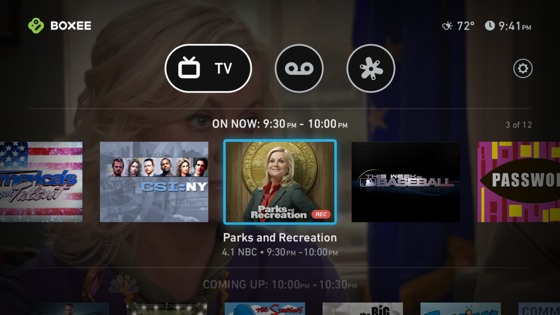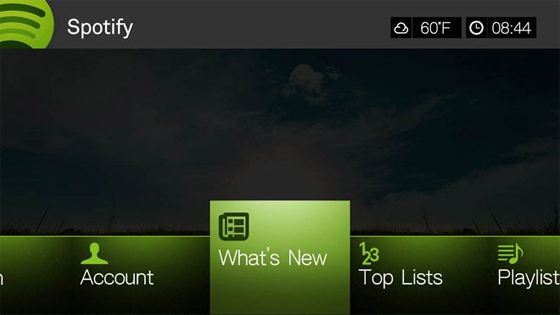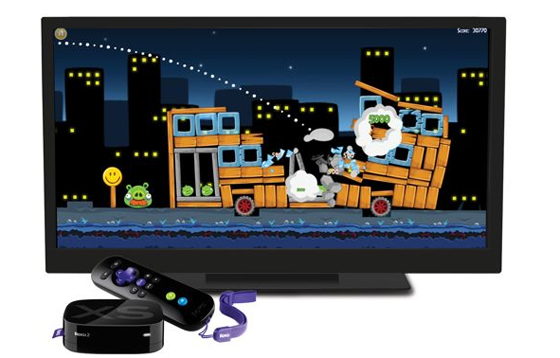Titans like Apple, Microsoft, and Google have been grappling for ownership of the living room for years, but no matter how many new hobbies or revamped interfaces roll out, none of the major players have become the de facto standard for home entertainment just yet. As a result, numerous competitors have rushed in with their own take on the streaming media box. While companies like Roku and Boxee focus exclusively on entertainment solutions — with varying degrees of success — there are also options by brands you’d never associate with the living room. From Western Digital to Netgear, it seems like anyone that can slap an HDMI port into a plastic shell wants in on the game.
The benefit of these other players, ostensibly, is choice: instead of buying into an integrated hardware and software ecosystem, you use a selection of third-party services that meet your needs. To get a sense of what it would be like to run my entertainment life out of the independent side of the spectrum, I spent a week with four different media boxes: the Netgear NeoTV Pro, the Roku 2 XS, Western Digital’s WD TV Live, and the new Boxee TV.
Film / TV

The good news is that if a movie is available anywhere online, you’re likely going to have access to it
Since none of the independent companies have their own store, they rely on services like Netflix, Vudu, and Hulu Plus. All four of the boxes I looked at feature these services — save the Boxee TV, which unfortunately doesn’t have Hulu Plus — while Roku adds some additional choices like Amazon Instant and Crackle. (We detailed the services provided by most modern streaming boxes in our buying guide this year). The good news is that if a movie is available anywhere online, you’re likely going to have access to it with these core services. I was able to find most current releases on Vudu — The Avengers, Hunger Games, and Prometheus, to name a few — for either purchase or rental (if you’ve dabbled with UltraViolet, you’ll be able to access that collection with Vudu as well). For older or foreign films aimed at the cinephile set, Hulu Plus rounds things out nicely due to its deal with The Criterion Collection.
As a primary storefront, however, Vudu leaves something to be desired. The service offers three tiers of pricing for both rentals and purchases — breaking it down by 480p, 720p, and 1080p content — but in several instances Vudu’s 1080p price was higher than what Amazon charged for the same movie. (By way of comparison, iTunes tends to track Amazon’s pricing for purchases, with rentals generally running a dollar or so more.) Vudu’s pricing issue is exacerbated by its less-than-stellar video quality. The service provided a soft picture on all of the devices, with nasty artifacting rearing its head from time to time — even on a 25 Mbps connection. I quickly found myself jumping straight to Amazon when I used the Roku, and begrudgingly exploring Vudu when on the other devices.
Television is another topic entirely. Both Netflix and Hulu Plus offer a healthy back catalog of television programs, with the latter also featuring a selection of current shows the day after they air (it was my go-to for The Daily Show and any NBC programming). Some current shows are available through Vudu or Amazon as well, but they’re not cheap. The Walking Dead ran $2.99 per high-definition episode, with a season bundle coming in as high as $41.99 (the DVD set for the show’s last season now sells for around $26). When it comes to pay-cable fare, Roku brings HBO Go to the table — but other than that, you’re out of luck entirely.
The standout here, of course, is the Boxee TV. With the help of either an antenna or a cheap basic cable plan, the Boxee TV lets you watch your local networks for live programming, sporting events, or news — and it has a cloud-based DVR as well. We’ll have a full review of the device in the coming weeks, but suffice to say that when I wanted to watch Oregon and USC battle it out, or follow the results of the presidential election, the Boxee TV was the only option on the table. Granted, you can hook any television with a tuner up to an antenna and pull local stations from the air, but in terms of an integrated experience the Boxee TV stands alone.
That’s not to say sports fans are otherwise hung out to dry. Several major sporting leagues offering subscription or pay-per-view services that let customers watch games on their mobile devices or streaming boxes. While I wasn’t able to test these services for myself — MLB.tv blacks out its live streaming for the entirety of the post-season — the Roku 2 XS offers a broad selection, with baseball, soccer, hockey, and UFC all represented. The WD TV Live and Boxee TV also feature the MLB app.
It was hard to escape the feeling that Netgear and Western Digital are pulling a bait and switch
Several of the boxes also have “sports” sections, but I found them filled with repackaged podcasts or apps with relatively useless video snippets (SEC Digital Network, I’m looking at you). The masquerade popped up again in the “television” category available on several of the devices — sections littered with dozens of so-called channels that were really nothing more than warmed-over web content. Yes, I was able to watch Anderson Cooper’s daily podcast wrap-up, but that’s not the same thing as watching CNN, and presenting it as television is misleading to say the least. Roku appointed itself well — it breaks out podcast-based programming into specific subject groups like “Science & Technology” — but it was hard to escape the feeling that both Netgear and Western Digital are pulling a bit of a bait and switch.
Music

If you’ve got a nice stereo in your home, it’s likely part of your living room set-up, making music a natural fit for these devices. Pandora was available on all four boxes, and in a lot of ways it’s the perfect background option: you set it to a channel and just walk away. Unfortunately I’ve grown accustomed to more full-featured services, so I turned to Spotify on the Boxee TV and WD TV Live, and Rdio and MOG on the Roku.
If you sign up for the top-tier paid plan, these music apps offer a basic set of features. You have access to your Spotify and Rdio playlists, but you won’t find the full range of social sharing features they’re known for. None of the apps would be considered a great experience, however. When put up against their websites or mobile apps, the television versions were just cumbersome, and I never found myself turning to them as my first choice for music.
Stepping away from the major players became a major problem
I also have a large music collection of my own — and here’s where stepping away from the major players became a noticeable problem. Roku, Boxee, and Western Digital let you attach external storage or connect to media servers to access your personal collection, but all of my music is in the cloud at this point. In fact, it’s actually stored in three different cloud services — with Google, Apple, and Amazon — yet there’s currently no way to access those songs from any of these devices. While Spotify and Rdio have a pretty good selection of artists, they simply don’t have all of the obscure tracks I’ve collected over the years. Relying on home media servers in 2012 doesn’t just feel complicated; it feels antiquated.
If you’re a music fan, this is perhaps the single biggest argument against purchasing one of these boxes over an Apple TV or other competitor (a scan-and-match music locker is coming to the Xbox 360 next year). No matter how many streaming services are available, I want to be able to access all of the content I own from the cloud at my leisure. That’s not to say this functionality couldn’t come to these devices with future updates — Amazon in particular seems a likely fit — but as it stands, all four are lacking.
Games & apps

Games and apps have become a hyped selling point with smart TVs and boxes like these, and it makes sense: the living room is a natural place for gaming, while apps and social media have become woven into our daily lives. All of the products save the Boxee TV feature some sort of gaming — though it’s an extremely relative term. The NeoTV and the WD TV Live feature a selection of free titles, but truthfully they represent nothing more than the type of primitive games Apple once touted for the click-wheel iPod: riffs on sudoku, mahjong, and blackjack. The Roku 2 XS, which comes pre-installed with Angry Birds, does only slightly better. Truthfully, the games all felt like curiosities instead of something I ever wanted to play. Is it nice that there’s a version of Jeopardy! on the Roku for $1.99? I suppose. Did I ever feel compelled to play? Not in the slightest.
Slogging through a slow interface to post a Facebook update doesn't make sense
The same held true for the apps themselves. There are some decent options — almost all of the boxes offer some combination of Picasa, Flickr, or Shutterfly clients, so it’s easy enough to bring your photos to the big screen. As a video source, YouTube is a logical choice (though depending on the app on your device it can range from usable to useless). The emphasis on social networking apps, however, is just a waste. I enjoy using Twitter and Facebook to comment on movies or shows — but not when it gets in the way of watching the program itself. Stopping a movie to slog through a slow interface and clunky app just to post a Facebook update just doesn’t make sense. Roku seems to get this; it has no Twitter app, and its Facebook client is simply a way to view photos and videos — a use perfectly suited for the television.
Interaction
As a whole these devices are slow and have disappointing remote controls
When switching between devices, similarities quickly become apparent, and two shared weaknesses were very clear: as a whole these devices are slow, and have disappointing remote controls. It wasn’t clear if the lack of responsiveness was due to underpowered processors, the IR remotes, or some combination of the two — but it was almost always a case of pressing a button, waiting a beat, and then seeing the device react. The Roku remote was solid in the hand with an appealing texture, but otherwise the remotes felt frustratingly cheap and awkward. The Boxee TV remote was the most disappointing, if only because the one that shipped with the original Boxee Box was so solid and responsive.
All of the streaming boxes offer smartphone or tablet remote apps as well, but they don’t fare much better. The key to a great remote app is its ability to adapt and anticipate; automatically pulling up a keyboard when you’re typing in a search field, or changing its layout based on the task you’re performing. Unfortunately none of the apps provided that kind of experience. Instead they were just awkward reproductions of the physical remotes themselves, cramming far too many touch targets onto a smartphone screen. The Boxee TV remote wasn’t even compatible with the Vudu and Netflix apps — though to be fair, the device had just launched when I tested it, and an update will no doubt address that particular issue.
Wrap-up
Ultimately what we’re left with are a number of products seeking to differentiate themselves not by creating a well-defined ecosystem of integrated products, but by assembling as many third-party services as possible in the hopes of adding value as a whole. On the surface it seems to be a compelling approach: by not having to worry about being locked into Apple or Microsoft’s walled content gardens, consumers have the opportunity to choose the precise services they want. That’s only a benefit, however, if the choices are actually worthwhile in the first place.
When I want to watch movies or TV, I want as little friction as possible
The big three of Apple, Sony, and Microsoft all offer Netflix and Hulu Plus — if not Amazon Instant — on their respective consoles or streaming boxes, so there’s no advantage there. Vudu may be available on many different devices, but it doesn’t hold up to the likes of iTunes or Amazon Instant in video quality. Games, social apps, and music services are all great bullet points when you’re browsing the aisle at Best Buy, but when they’re not good enough to actually use they just become white noise.
When I want to watch a movie or a television show, I’m looking for an experience that provides as little friction as possible. The television has always been a uniquely turnkey product — even in the face of increasingly complex DVRs. Roku and the Boxee TV were the clear standouts in this regard, if only because they’re clearly designed and presented as entertainment devices above all else — something Netgear and Western Digital could take note of.
That said, I found myself yearning for the Apple TV, with AirPlay and its integration with Cupertino’s media services. When it came to gaming, I kept wondering if it wouldn’t make more sense to just power up the Xbox 360 and explore Microsoft’s own store of casual games. For access to a wide variety of third-party content services, I was more inclined to turn to the PlayStation 3; no matter what you think of the XrossMediaBar, it’s fast and responsive, and it never feels like you’re using anything less than a top-tier device.
With online content selection more or less locked at a standstill until media companies decide to open the gates — or an unexpected third party creates some true disruption in the space — the defining characteristics of a streaming set-top box become polish and execution. While the independent world certainly offers choice, if you’re looking for a convenient, high-end experience, they’re not quite there just yet.
Explore the ecosystems
This week we're taking a close look at the future of TV and the living room — the great unclaimed space of the technology world. Check back each day for a close look at all the major players, along with a full range of interviews with industry players and reports on everything from the state of remote controls to the future of gaming. Tune in all week for the rest. Here’s a sampling:
Tuesday: Google, Microsoft, Aereo, Boxee CEO Avner Ronen
Wednesday: Amazon, Sony, live sports, TV apps, Condé Nast’s Dawn Ostroff, NBC's Vivian Schiller
Thursday: Apple, the state of remotes, Vizio CTO Matt McRae
Friday: Independents, New Yorker's Emily Nussbaum, Valve
:format(webp)/cdn.vox-cdn.com/uploads/chorus_asset/file/14129512/ecosystems_indies_crop.1419978997.jpg)